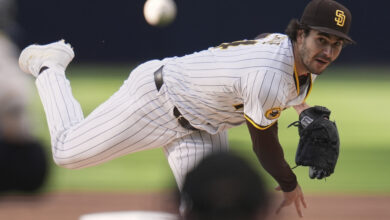
Cubs Get Tiny Win in Descalso-for-La Stella Moves, Just Not for Obvious Reasons
If the Cubs replacing Tommy La Stella with Daniel Descalso feels like moving cheap Italian deck furniture around, it’s because that’s what it is. The two players are fairly interchangeable end-of-benchers. No one really wants to depend on them regularly unless forced.
The swap does represent a tiny possible upgrade for the Cubs, but not for obvious reasons. The first is that this represents the first slight change to a clubhouse in which Theo Epstein identified complacency (the sterner version of “lack of urgency”) as an increasing problem. La Stella was hardly the cause or a major reflection of that issue, and trading one of the more regular young players would jolt the clubhouse far more. But if Descalso can bring even a little new hunger and competitive urgency, all the better.
Plus Descalso presumably is a more mature individual at age 32. He’s been married for five years, having wed his high school girlfriend 10 years after they started dating. Is he a gym-rat type who loves talking baseball in every off moment in hotels and on the team plane? Of course, now we are fully into tea-leaf reading as we really will never know Descalso or any player’s true character off the field, but presumably the Cubs front office does know more and would factor this in.
This said, be wary of the oversell. The Athletic (subscription required/recommended) appeared to do this today by pointing to Descalso’s leadership qualities as a possible plus. Of course, every player can contribute to a professional, accountable clubhouse, but this kind of talk about a bench player tends to be fairly naive/wishful. Teams that must rely on key leadership from their bench usually have a leadership vacuum. See the Cubs in 2017 and the role Jon Jay needed to play in calling team meetings.
The lone exception I know was David Ross for the Cubs in 2015 and 2016. But Ross was a better player than both Jay and Descalso, as well as a unique person and personality. He also could only lead from the bench because so many key established players conferred such respect on him. This included Jon Lester in 2015 and then Jason Heyward and John Lackey in 2016. So lets hope Descalso contributes positively to the clubhouse, but also keep some perspective.
The second reason is Conor Lillis-White, the player the Angels sent back for La Stella. Not to overblow how good Lillis-White is — after all, he was exposed to the Rule 5 draft and no takers came knocking. But he is a solid Triple-A “flyer.” By this I mean an arm worth a role of the dice, not unlike fellow lefty Randy Rosario who the Cubs claimed on waivers from Minnesota a year ago.
Like Rosario, Lillis-White has a mix of good and bad minor league stats. In his career, Lillis-White sports a high-K arm (11.9 K/9), but also a high walk rate: 4.0 BB/9. So for a small increase in payroll, the Cubs in effect swapped out La Stella for Descalso, a small clubhouse change, and a solid lefty addition to the Iowa Shuttle.
These are tiny moves to be sure, and neither new player should be expected to win a playoff game. However, these moves appear to involve a decent amount of front-office thought. Now, would I have preferred the Cubs to have held onto Drew Smyly as that extra bullpen lefty? Yes, but if Smyly can make the Rangers’ rotation, maybe his trade will turn into an equally credible bullpen arm as the player to be named later.
Back to Descalso. Am I excited about his addition? Not really. He and La Stella have the same .202 career batting average with runners in scoring position, and you don’t want either starting full-time defensively. Descalso did hit slightly better as a starter last year (.236 to .222) and generally has more power than La Stella. However, Descalso loses all slugging advantage against power arms with a career power-arm slash line (.217/.315/.336) far inferior to La Stella’s (.257/.343/.401).
This is important because most pinch-hitting opportunities come against power arms, which accounts for La Stella’s big advantage as a pinch hitter over Descalso (career .278 versus .218). Such a downgrade should be a concern for a Cubs lineup that features way too much swing-and-miss against hard-throwers already. Descalso’s 30 percent K-rate last year against power arms (versus La Stella’s 13 percent) only adds to the problem. But this should be a marginal issue assuming Descalso doesn’t equal the 423 plate appearances he got last year with Arizona.
But again, it would appear Theo Epstein swapped out La Stella for Descalso for reasons other than simply on-field performance. After all, Descalso costs a tad more this year: $2.5 million AAV versus an expected $1.2 million for La Stella in arbitration. But for that extra salary, the Cubs in effect bought themselves a lefty reliever who could help out in spurts and maybe a directionally positive clubhouse change.
Again, these are all very marginal changes. Let’s just hope before the 2019 season begins, the front office puts the same brain effort into one or two more roster changes of much greater consequence.

